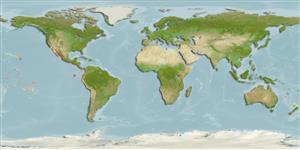Common names from other countries
Environment: milieu / climate zone / depth range / distribution range
Écologie
marin récifal; profondeur 5 - 25 m (Ref. 9324). Tropical
Eastern Pacific: Gulf of California to Islas Lobos de Afuera, Peru, including the Galapagos Islands.
Taille / Poids / Âge
Maturity: Lm ? range ? - ? cm
Max length : 61.0 cm TL mâle / non sexé; (Ref. 5590); common length : 35.0 cm TL mâle / non sexé; (Ref. 57763)
Description synthétique
Clés d'identification | Morphologie | Morphométrie
Head and jaws very much compressed; body tapering posteriorly. Body depth at the middle about 1/13 of the entire length; the head about 1/7, measured to the branchial orifice. Jaws very narrow, sharp-pointed and equal. Gape deeply cleft. Teeth compressed at the sides, very sharp, slightly hooked and pointing backwards. Two tubular orifices above the eyes and two at the extremity of the snout. Distance of eyes from the end of the snout about twice the eye diameter. Branchial orifice and eyes of same size. Dorsal fin thick and fleshy. Color is fine dark purplish brown, with yellow circular spots; the spots mostly small. (Ref. 3157).
Often seen in shallow water. Remains under cover in rocky crevices during the day. Feeds mainly at night on crustaceans and fishes (Ref. 6852). Constantly opens and closes it mouth, an action required for respiration, not a threat (Ref. 5227).
Life cycle and mating behavior
Maturities | Reproduction | Spawnings | Egg(s) | Fecundities | Larves
Merlen, G., 1988. A field guide to the fishes of Galapagos. Wilmot Books, London, England 60 p. (Ref. 5590)
Statut dans la liste rouge de l'IUCN (Ref. 130435)
CITES (Ref. 128078)
Not Evaluated
Menace pour l'homme
Harmless
Utilisations par l'homme
Outils
Articles particuliers
Télécharger en XML
Sources Internet
Estimates based on models
Preferred temperature (Ref.
115969): 22.3 - 29.1, mean 26.7 (based on 244 cells).
Phylogenetic diversity index (Ref.
82804): PD
50 = 0.5010 [Uniqueness, from 0.5 = low to 2.0 = high].
Bayesian length-weight: a=0.00050 (0.00025 - 0.00101), b=3.26 (3.10 - 3.42), in cm Total Length, based on LWR estimates for this (Sub)family-body shape (Ref.
93245).
Niveau trophique (Ref.
69278): 3.9 ±0.61 se; based on food items.
Résilience (Ref.
120179): Milieu, temps minimum de doublement de population : 1,4 à 4,4 années (Preliminary K or Fecundity.).
Fishing Vulnerability (Ref.
59153): Moderate vulnerability (44 of 100).
